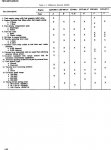reading back it seems to have been established that the differences that haven't been tested (others were tested to make no difference) are:
-lower compression (= higher volume of air from turbo accepted without increasing exhaust temps)
-different rocker arms (a higher ratio would = more valve clearance = more air)
good point on the CR - i was trying to recall (without going back through all 90 posts) whether the rotating assembly was the same.
if the crank and rods are the same part #'s and the piston pin heights are the same between the two motors, then CR should be the same unless there are differences in the head chambers.
however, i don't see a CR change being responsible for adding 50-70+ horsepower over the LDT.
my opinion based on what i've learned: diesels make power based on fuel. and you can alter fuel delivery to make more power without changing any other aspect, including air. fuel delivery pressure, fuel delivery velocity, injector orifice count and size, spray pattern, combustion bowl design, and other things can be altered and have affect on power without increasing EGT or putting combustion pressures above safe levels.
that's my theory without know much about anything.



